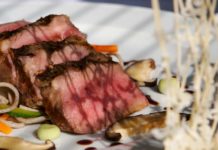
The flank steak is a lean, flavorful, boneless beef cut from the well-exercised belly muscles of the cow. Long and flat, the flank steak’s best-known application is London Broil, which is a misnomer, since the dish did not originate in London at all. The popularity of London Broil has driven up the price of flank steak over the past few decades, but it is still one of the most affordable steaks on the market. It is substantially tougher than the loin and rib steaks; however, when marinated, broiled or cut against the grain, flank steak becomes quite tender. Because marinades include acids such as tomato-based products, lemon juice, wine, vinegar, pineapple or ginger, they tend to be tenderizing. Flank steak is frequently used in Asian cuisine. Keep in mind that a good marinade should have a delicate balance of spices, acid, and oil. There are also many recipes for using a moist cooking method such as braising, which also tenderizes the meat.
Buying and storing Flank Steak
It is best to purchase flank steak that has a clear red color. Beef normally is purplish-red, but when exposed to oxygen it takes on a cherry-red hue known as the bloom.’ While the exterior is bright red, the interior of the meat retains the darker color. Vacuum-packed flank steak also shows this purplish color. Packaged flank steak should be cold and the packaging free of punctures or tears; vacuum-packed flank steak should have its seal intact. The beef should be firm to the touch. Check the label for the ‘sell-by’ date and make sure to buy it before or on that date.
Flank steak may be stored in its original packaging in the coldest part of the refrigerator, where it will keep for three to four days. It also may be frozen in this packaging for up to two weeks. If you expect to freeze the meat for a longer period, it is best to wrap the meat in heavy-duty aluminum foil, freezer paper, or freezer bags. Securely wrapped flank steak will keep 6 to 12 months in the freezer. When you are ready to use, defrost the meat in the refrigerator, allowing 12 to 24 hours, depending on size and number of steaks. Cook as soon as possible after defrosting.
Preparation, uses, and tips
Flank steak can be broiled or grilled if it is marinated first. Place the flank steak in an acid-resistant container, add marinade (1/4 to 1/2 cup [59.1’118.3ml] for each 1 to 2 pounds [0.45’0.90 kg] of meat), and turn to make sure the marinade touches all surfaces. Cover, and place in the refrigerator for several hours or overnight. Marinades can be used to baste meat while cooking or make a sauce. However, once the marinades have come in contact with raw meat, never consume them unless they have been thoroughly cooked so that all microorganisms are destroyed.
To broil, place marinated flank steak on a broiling pan 2 to 3 inches (5’7.6cm) from the heat source. Leave the oven door open, and broil 6 to 7 minutes on each side for medium rare, 9 minutes on each side for medium. Avoid overcooking, because it makes flank steak become tough.
To grill, place marinated flank steak directly over the heat source and cook, uncovered, over medium heat for 17 to 21 minutes, turning once during cooking.
To stuff and bake, prepare the stuffing mixture and lay the flank steak flat on a work surface. Spread stuffing over the surface of the steak, and then roll up the meat as if it were a jellyroll. Tie every 2 inches (5cm) with cotton string. Place in a baking pan and bake at 350’°F (177’°C) for 40 minutes. Cool slightly before slicing.
To braise, heat a skillet over medium-high heat, add oil, and brown steak on both sides. Add cooking liquid and seasonings. Reduce heat and simmer until tender, 1 1/4 to 1 3/4 hours.
The French are quite partial to flank steak, known as “Bavette.’ It is quickly seared in a hot pan and eaten rare to maintain its tenderness. Strips of flank steak, known as arrachera, are very popular in Mexican cuisine and may be used to fill tacos, or served in large pieces as a main course. Flank steak used in Mexican cuisine may be tenderized by a marinade, or by mechanical tenderizing, using a machine similar to that used to produce cube steaks.
In Chinese markets, the flank steak is often sold as “stir-fried beef” because that is how it is usually prepared. Most stir-fried beef dishes in Cantonese restaurants are prepared with this cut of beef. The meat is sliced across the grains into one inch by 2 inch pieces about one eighth inch thick. The slices are first lightly coated with cornstarch and cooking oil before sugar, salt, and soy sauce are added to the marination. Other ingredients of the dish are often cooked first. The marinated beef slices are added last or stir-fried separately in a very hot wok for about 30 seconds. To ensure tenderness, the beef is scooped out of the wok before it is fully cooked because the meat will continue to cook in its own heat on the serving plate. Common mistakes in stir-frying beef are over-cooking and marinating without first coating the beef with oil and starch, both cause loss of moisture and result in dried and tough texture of the meat.
Nutritional Highlights
Beef (flank, cooked), 3 oz. (85.05g)
Calories: 192.1
Protein: 22.4g
Carbohydrate: 0.0g
Total Fat: 10.6g
Fiber: 0.0g





